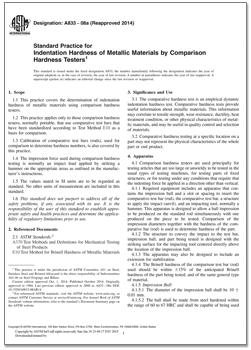英文名稱:
ASTM A833-08a(2014)
Standard Practice for Indentation Hardness of Metallic Materials by Comparison Hardness Testers
中文名稱:
ASTM A833-08a(2014)
使用比較硬度計測試金屬材料壓痕硬度的標(biāo)準(zhǔn)規(guī)范
代號說明:
This standard is issued under the fixed designation A833; the number immediately following the designation indicates the year of original adoption or, in the case of revision, the year of last revision. A number in parentheses indicates the year of last reapproval. A superscript epsilon (ε) indicates an editorial change since the last revision or reapproval.
版本說明:
1 This practice is under the jurisdiction of ASTM Committee A01 on Steel,Stainless Steel and Related Alloysand is the direct responsibility of Subcommittee A01.06 on Steel Forgings and Billets.
Current edition approved Oct. 1, 2014. Published October 2014. Originally approved in 1984. Last previous edition approved in 2008 as A833 – 08a DOI: 10.1520/A0833-08AR14
2 For referenced ASTM standards, visit the ASTM website, www.astm.org, or contact ASTM Customer Service at service@astm.org. For Annual Book of ASTM Standards volume information, refer to the standard’s Document Summary page on the ASTM website.
標(biāo)準(zhǔn)正文:
1. Scope
1.1 This practice covers the determination of indentation hardness of metallic materials using comparison hardness testers.
1.2 This practice applies only to those comparison hardness testers, normally portable, that use comparative test bars that
basis for comparison.
1.3 Calibration of comparative test bars (rods), used for comparison to determine hardness numbers, is also covered by this practice.
1.4 The impression force used during comparison hardness testing is normally an impact load applied by striking a hammer on the appropriate areas as outlined in the manufacturer’s instructions.
1.5 The values stated in SI units are to be regarded as standard. No other units of measurement are included in this standard.
1.6 This standard does not purport to address all of the safety problems, if any, associated with its use. It is the responsibility of the user of this standard to establish appropriate safety and health practices and determine the applicability of regulatory limitations prior to use.
2. Referenced Documents
2.1 ASTM Standards:
A370 Test Methods and Definitions for Mechanical Testing of Steel Products
E10 Test Method for Brinell Hardness of Metallic Materials
3. Significance and Use
3.1 The comparative hardness test is an empirical dynamic indentation hardness test. Comparative hardness tests provide useful information about metallic materials. This information may correlate to tensile strength, wear resistance, ductility, heat treatment condition, or other physical characteristics of metallic materials, and may be useful in quality control and selection of materials.
3.2 Comparative hardness testing at a specific location on a part may not represent the physical characteristics of the whole part or end product.
在線閱讀 免費(fèi)下載







